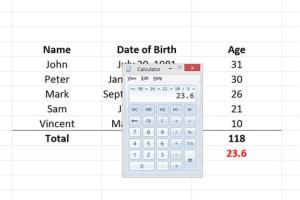Mastering the Calculation of Average Age: A Comprehensive Guide

-
Quick Links:
- Introduction
- Understanding Average Age
- Why Calculate Average Age?
- Different Ways to Calculate Average Age
- Step-by-Step Guide to Calculate Average Age
- Case Studies and Examples
- Common Misconceptions
- Expert Insights
- Challenges and Limitations
- FAQs
- Conclusion
Introduction
The concept of average age is vital across various fields, including demographics, healthcare, education, and social research. This article serves as a comprehensive guide to help you understand how to calculate average age effectively.
Understanding Average Age
Average age is a statistical measure that represents the central tendency of age within a group. It is calculated by summing all the ages and dividing by the number of individuals.
Why Calculate Average Age?
- To understand population demographics.
- For healthcare planning and resource allocation.
- To evaluate trends in age-related data.
- To inform policy decisions.
Different Ways to Calculate Average Age
There are several methods to calculate average age, including:
- Arithmetic Mean: The most common method, calculated by summing ages and dividing by the count.
- Median: The middle value when ages are ordered, useful in skewed distributions.
- Mode: The most frequently occurring age in a dataset.
Step-by-Step Guide to Calculate Average Age
Step 1: Collect Data
Gather the ages of all individuals in your dataset. Ensure the data is accurate and representative.
Step 2: Sum the Ages
Add all the ages together. For example, if you have ages 23, 30, and 45, the sum would be 98.
Step 3: Count the Individuals
Determine the total number of individuals in your dataset. In this example, it would be 3.
Step 4: Apply the Formula
Use the formula: Average Age = (Sum of Ages) / (Number of Individuals).
For our example: Average Age = 98 / 3 = 32.67.
Case Studies and Examples
Let’s explore some real-world scenarios where calculating average age has been crucial:
Case Study 1: Healthcare Planning
In a study conducted by the CDC, understanding the average age of patients with chronic conditions helped tailor healthcare services to better meet the needs of the population.
Case Study 2: Educational Research
A local school district analyzed the average age of students to develop age-appropriate curriculum changes, resulting in improved student performance.
Common Misconceptions
- Many believe that average age always reflects the typical age, but it can be skewed by outliers.
- Some confuse median and average age, although they serve different purposes.
Expert Insights
Experts suggest using median age in populations with significant age variations to provide a clearer picture. For example, in a dataset with a few elderly individuals, the mean age may not represent the majority accurately.
Challenges and Limitations
Calculating average age can present challenges such as:
- Data Quality: Inaccurate or incomplete data can lead to misleading results.
- Outliers: Extreme ages can skew the average, making it less representative.
FAQs
1. What is the difference between average age and median age?
The average age is the sum of all ages divided by the number of individuals, while the median age is the middle value in a sorted list of ages.
2. How do you calculate average age with outliers?
Consider using the median age, as it is less affected by extreme values compared to the average.
3. Can average age be negative?
No, average age cannot be negative as age is a non-negative number.
4. What are some applications of average age?
Average age is used in demographics, market research, healthcare, and social studies.
5. How can I improve the accuracy of my average age calculation?
Ensure your dataset is comprehensive and accurately reflects the population you are studying.
6. Is there a software to calculate average age?
Yes, many statistical software programs can calculate average age, including Excel, SPSS, and R.
7. What is a weighted average age?
A weighted average age considers different weights for different groups within a dataset, providing a more accurate reflection of the overall average.
8. Why is average age important in marketing?
Understanding the average age of your target audience helps tailor products and marketing strategies effectively.
9. How often should average age be recalculated?
It should be recalculated whenever there is a significant change in the population or when new data becomes available.
10. Can I calculate average age for a small group?
Yes, average age can be calculated for any size group, but small samples may lead to less reliable results.
Conclusion
Calculating average age is a fundamental skill across various fields. By following the steps outlined in this guide and being aware of the challenges and limitations, you can derive meaningful insights from your age data.
For more information on statistical analysis and demographic studies, consider exploring resources from CDC and Statistics Canada.
Random Reads
- How to track a cell phone
- How to felt a pool table
- How to fight mobs in minecraft
- How to remove email contacts from an iphone
- Send text message to email
- Show chunk borders minecraft
- How to use wood hole filler
- How to use your own router with verizon fios
- Clean velvet upholstery clothing
- Clean up slow computer